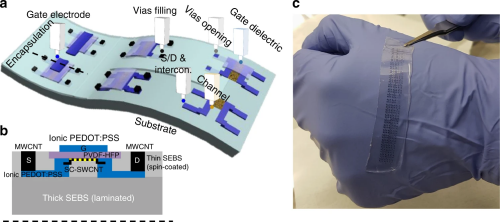Inkjet‑printed stretchable and low voltage synaptic transistor array
Our researcher Thomas Öhlund has spent a year as a postdoc at Stanford University in California USA. There he participated in and developed the research on extensible transistors that can be used for bioelectronics.
A scientific article has been published in the journal Nature Communications. Thomas Öhlund has contributed to the work and the article together with 10 researchers from different parts of the world.
“We have developed materials and processes for transistors that are extensible and powered at low voltage so that they can be used in the human body."
"The materials in our transistors are mechanically and chemically compatible with biological tissue. They can withstand fluid environments and have the right electrical properties to connect with neurons in the body. My contribution to the research has mainly been about the manufacturing process, which is entirely inkjet-based. It is a technology that is flexible and environmentally friendly and can be used on many different surfaces, ”says Thomas Öhlund.

Research has verified that the transistors act as synapses and respond to pulses in the same way as neurons. An interface could be against sensors located in the human body, connected to the brain or other organs. Our transistor switches relatively slowly, softly and smoothly. It fits well in human organs.
“At Stanford University, several projects are being conducted in similar areas. The research environment is very interesting and dynamic. New researchers from different parts of the world are constantly arriving. The research leader ensures that the projects hold together and have good continuity despite the fact that many researchers come and go. It was a very exciting and good year for me and my research, ”says Thomas.
During this time, Thomas has also worked with electrically conductive polymers and nanocellulose composites based on these. The article was published in Nature Communications during the summer. Here you can read the whole article.
Wearable and skin electronics benefit from mechanically soft and stretchable materials to conform to curved and dynamic surfaces, thereby enabling seamless integration with the human body. However, such materials are challenging to process using traditional microelectronics techniques. Here, stretchable transistor arrays are patterned exclusively from solution by inkjet printing of polymers and carbon nanotubes. The additive, non-contact and maskless nature of inkjet printing provides a simple, inexpensive and scalable route for stacking and patterning these chemically-sensitive materials over large areas. The transistors, which are stable at ambient conditions, display mobilities as high as 30 cm2 V−1 s−1 and currents per channel width of 0.2 mA cm−1 at operation voltages as low as 1 V, owing to the ionic character of their printed gate dielectric. Furthermore, these transistors with double-layer capacitive dielectric can mimic the synaptic behavior of neurons, making them interesting for conformal brain-machine interfaces and other wearable bioelectronics.
